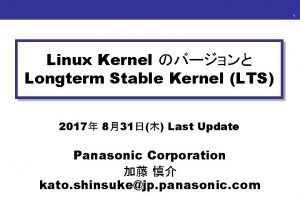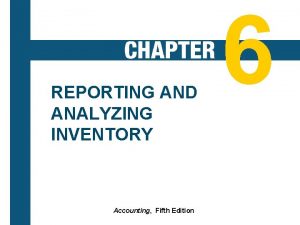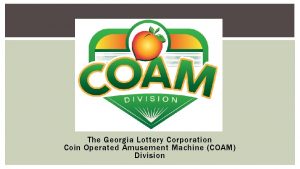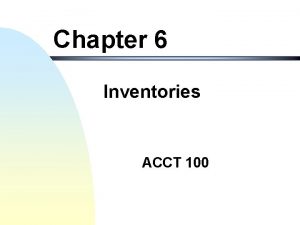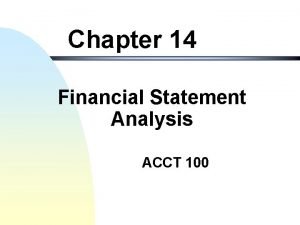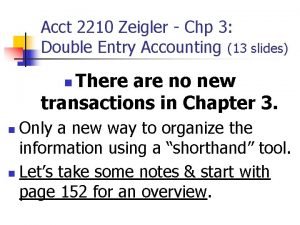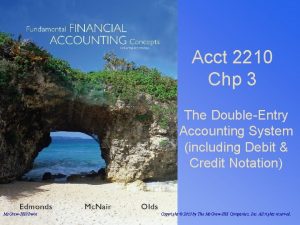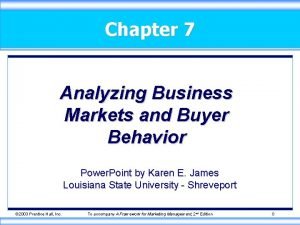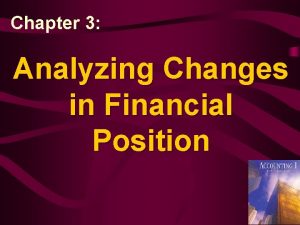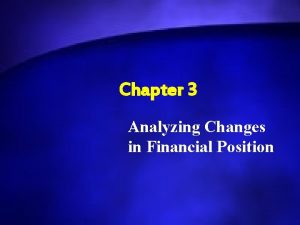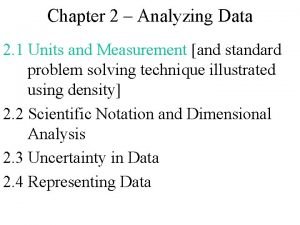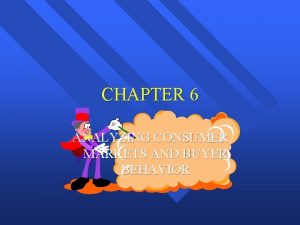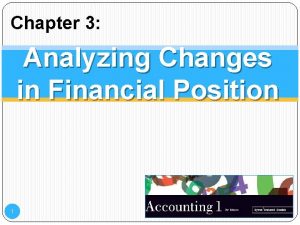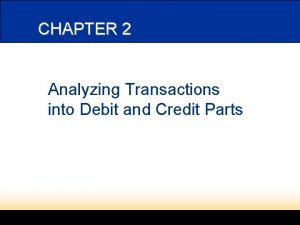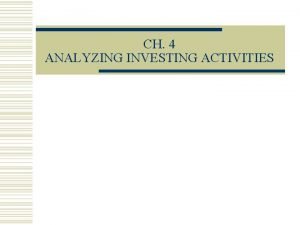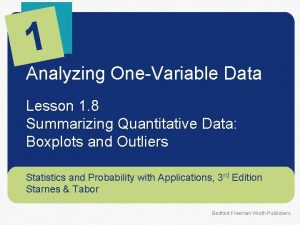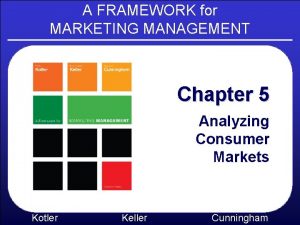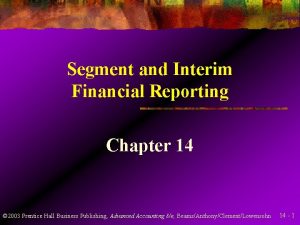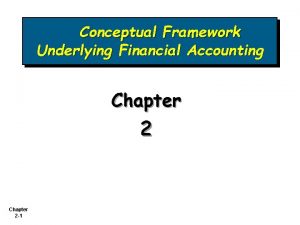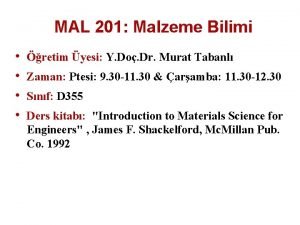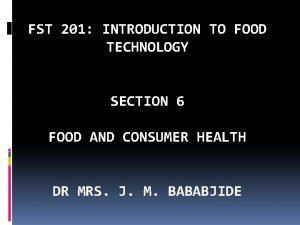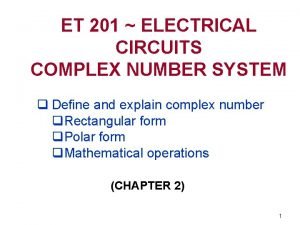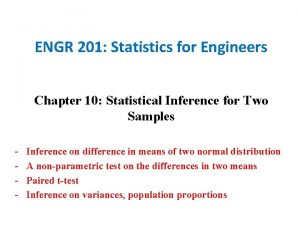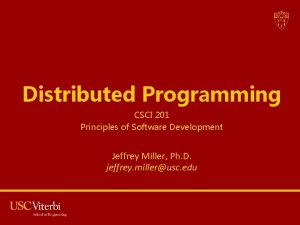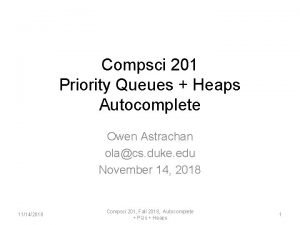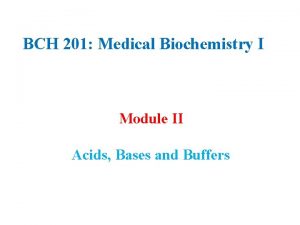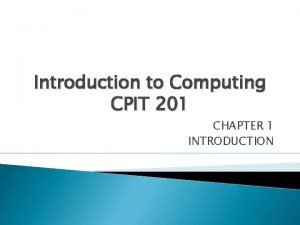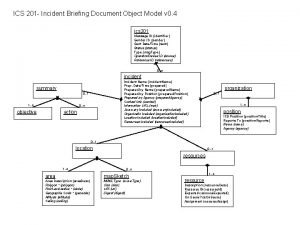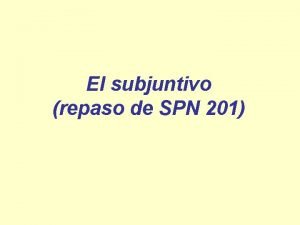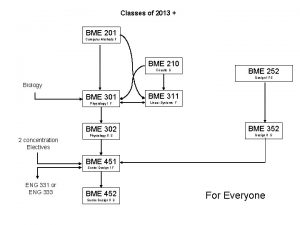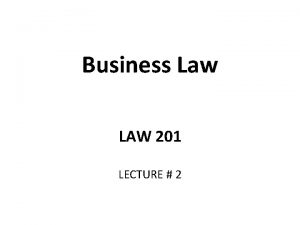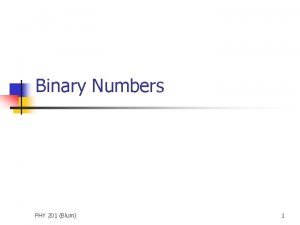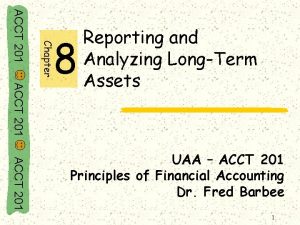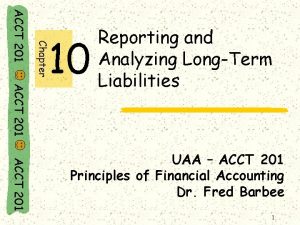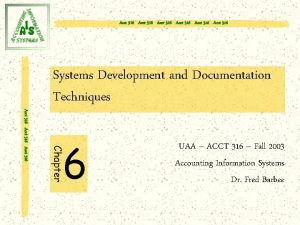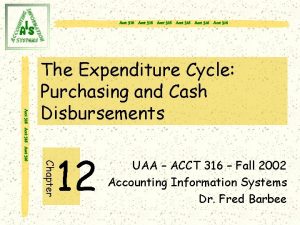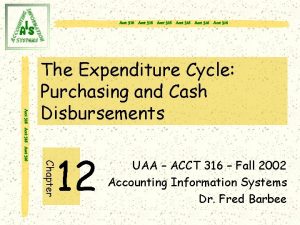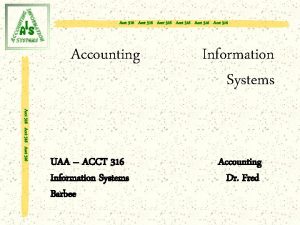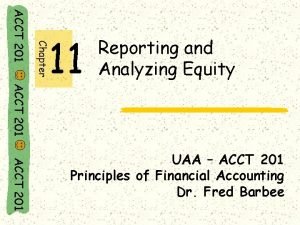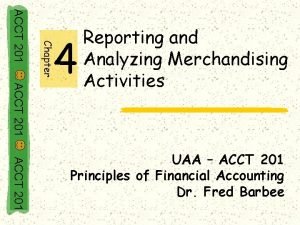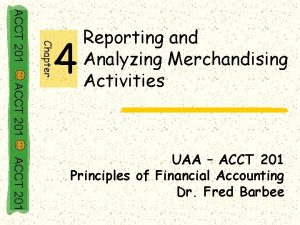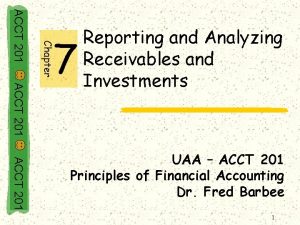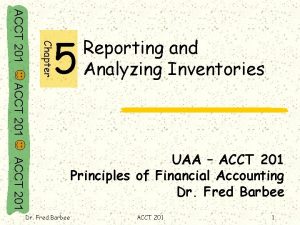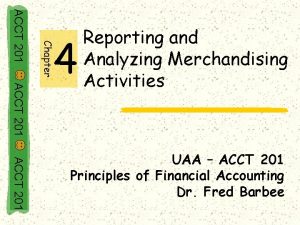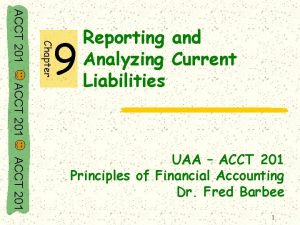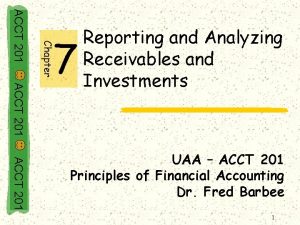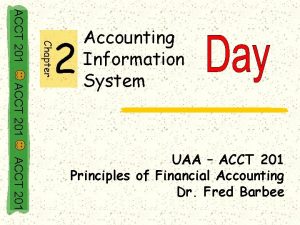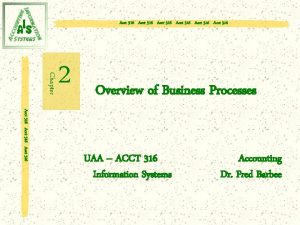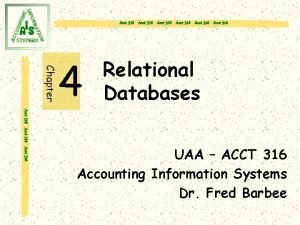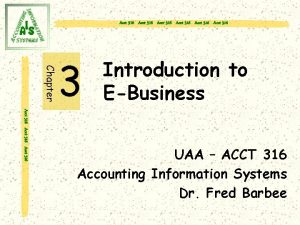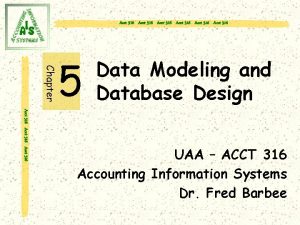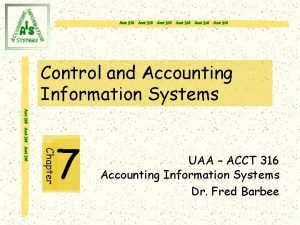Chapter ACCT 201 10 Reporting and Analyzing LongTerm






































































- Slides: 70

Chapter ACCT 201 10 Reporting and Analyzing Long-Term Liabilities ACCT 201 UAA – ACCT 201 Principles of Financial Accounting Dr. Fred Barbee 1

2

Chapter 10 - Day 1 - Agenda Topic Basics of Bonds Bond Issuances Present Value of Bonds and Notes LO Read HW A 1, C 1 422425 QS 1 P 1, P 2, P 3 425436 E 1, 2, 3, 4, 5, 6; P 1 C 3, C 4 445448 None No Homework Due Today! 3

ACCT 201 Basics of Bonds ACCT 201 Bond 4

Basics of Bonds Bond Selling Price Company Bond Certificate at Par Value Investors Bond Issue Date ACCT 201 5

Basics of Bonds Bond Interest Payments Company Bond Issue Date Bond Interest Payments Investors Interest Payment = Bond Par Value x Stated Interest Rate ACCT 201 6

Basics of Bonds Bond Par Value at maturity date Company Investors Bond Issue Date ACCT 201 Bond Maturity Date ACCT 201 7

ACCT 201 Advantages of Bonds ACCT 201 Bonds do not affect owner control. ACCT 201 Bonds can increase ROE. Interest on bonds is tax deductible. Bond 8

ACCT 201 Disadvantages of Bonds ACCT 201 Bonds require periodic payment of interest. ACCT 201 Bonds can decrease ROE. Bonds require payment of principal at maturity. Bond 9

Convertible and Callable Secured and Unsecured Types of Bonds Term and Serial Registered and Bearer 10

ACCT 201 Bond Trading ACCT 201 Bond market values are expressed as a percent of their par value. ACCT 201 11

ACCT 201 Bond Issuances ACCT 201 Bond 12

Bond Issuing Procedures A company sells the bonds to. . . An investment firm called an underwriter. The underwriter sells the bonds to. . . investors A trustee monitors the bond issue. 13

ACCT 201 Interest Rates and the Issue Price ACCT 201 14

ACCT 201 The Market Rate. . . ACCT 201 The rate of interest currently being demanded in the market, i. e. , the rate that investors expect to earn on their investment. ACCT 201 15

ACCT 201 The Market Rate. . . ACCT 201 The market rate is often referred to by other terms. . . The Effective Rate The Yield ACCT 201 16

ACCT 201 The Market Rate. . . ACCT 201 The rate used to compute the present values of the two components of the price of a bond: The Present Value of the interest payments; and ACCT 201 The Present Value of the face value at maturity. 17

ACCT 201 The Contract Rate. . . ACCT 201 The interest rate specified on the face of the bond and in the bond indenture. ACCT 201 18

ACCT 201 The Contract Rate. . . ACCT 201 The contract rate is often referred to by other names: The Stated Rate The Nominal Rate ACCT 201 The Coupon Rate 19

ACCT 201 The Contract Rate. . . ACCT 201 The contract rate is used only to calculate the amount of interest to be paid to the bondholders at each interest period. ACCT 201 20

ACCT 201 Interest Rates and the Issue Price ACCT 201 What Determines the Market Rate? 21

ACCT 201 The Market Rate. . . ACCT 201 In most cases the market price of bonds is influenced by. . . The riskiness of the bonds; and ACCT 201 The interest rate at which the bonds are issued. 22

ACCT 201 Riskiness of the Bonds ACCT 201 The risk factor is a combination of: The general economic conditions; and The financial status of the company selling the bonds, ACCT 201 Moody’s, or Standard and Poors 23

ACCT 201 Interest Rate on the Bonds ACCT 201 The interest rate on the bonds is primarily determined by the riskiness of the bonds. . . The higher the risk, ACCT 201 The higher the interest rate. 24

ACCT 201 Issuing Bonds Payable ACCT 201 What Determines the Issue Price? 25

ACCT 201 Issuing Bonds Payable ACCT 201 When issuing bonds payable, there are three possibilities. Bonds may be issued. . . At face value (par); ACCT 201 At a discount (less than par); or At a premium (greater than par). 26

ACCT 201 Bonds Issued at Face Value ACCT 201 If the market rate is equal to the contract rate, the bonds will sell at face value (i. e. , at par). 27

Issuing Bonds Payable Market Rate = Contract Rate Effective Market Yield Coupon Contract Nominal Bonds will sell at ACCT 201 28

ACCT 201 Bonds Issued at a Discount ACCT 201 If the market rate is higher than the contract rate, the bonds will sell at a discount (less than face value). 29

Issuing Bonds Payable Market Rate > Contract Rate Effective Market Yield Coupon Contract Nominal Bonds will sell at a ACCT 201 30

ACCT 201 Bonds Issued at a Premium ACCT 201 If the market rate is lower than the contract rate, the bonds will sell at a premium (more than face value) 31

Issuing Bonds Payable Market Rate < Contract Rate Effective Market Yield Coupon Contract Nominal Bonds will sell at ACCT 201 32

ACCT 201 Example #1 ACCT 201 Bonds Issued At Par Value 33

ACCT 201 Issuing Bonds at Par ACCT 201 Par Value = $1, 000 Stated Interest Rate = 10% Market Interest Rate = 10% Interest Dates = 6/30 & 12/31 ACCT 201 Bond Date = Jan. 1, 2002 Maturity Date = Dec. 31, 2021 (20 years) 34

ACCT 201 Bonds Issued at Face Value ACCT 201 If the market rate is equal to the contract rate, the bonds will sell at face value (i. e. , at par). 35

Issuing Bonds at Par The journal entry to record the issuance of bonds at par. ACCT 201 36

Issuing Bonds at Par The journal entry to record the six-month interest payment on June 30. This entry will be made every six months until the bonds mature. ACCT 201 37

Issuing Bonds at Par On Dec. 31, 202, when the bonds mature, the following entry would be made. ACCT 201 38

ACCT 201 Example #2 ACCT 201 Bonds Issued at A Discount 39

ACCT 201 Issuing Bonds at a Discount ACCT 201 Par Value = $1, 000, 5 Years Issue Price = 92. 6405% of par value Stated Interest Rate = 10% Market Interest Rate = 12% Interest Dates = 6/30 & 12/31 Bond Date = Jan. 1, 2002 Maturity Date = Dec. 31, 2006 40

ACCT 201 Bonds Issued at a Discount ACCT 201 If the market rate is higher than the contract rate, the bonds will sell at a discount (less than face value). 41

Issuing Bonds at a Discount $1, 000 92. 6405% Amortizing the discount increases Interest Expense over the outstanding life of the bond. ACCT 201 42

Issuing Bonds at a Discount On Jan. 1, 2002, the bond issue would be recorded as follows. Contra-Liability Account ACCT 201 43

Issuing Bonds at a Discount Maturity Value Carrying Value ACCT 201 44

Issuing Bonds at a Discount Using the straight-line method, the discount amortization will be $7, 360 every six months. $73, 595 ÷ 10 periods = $7, 360 (rounded) ACCT 201 45

Issuing Bonds at a Discount This entry will be made every six months to record the interest payment and the amortization of the discount. $73, 595 ÷ 10 periods = $7, 360 (rounded) $1, 000 × 10% × ½ = $50, 000 ACCT 201 46

$1, 000 x 10% x 1/2 $50, 000 + $7, 360 $73, 595/10 = $7, 360 (rounded) $66, 235 $7, 360 $1, 000 $58, 875 47

48

ACCT 201 What if the company used the effective interest method to amortize the discount? ACCT 201 49

ACCT 201 Effective Interest Method ACCT 201 The effective interest method allocates bond interest expense over the life of the bonds in a way that yields a constant rate of interest. 50

$1, 000 x 10% x 1/2 $931, 989 x 12% x 1/2 $55, 919 $50, 000 $68, 011 $5, 919 $1, 000 - $62, 092; or $931, 989 + $5, 919 51

52

Comparing Straight-Line and Effective Interest Methods Annual Interest Expense Both methods report the same amount of interest expense over the life of the bond. 53

ACCT 201 Example #3 ACCT 201 Bonds Issued at A Premium 54

ACCT 201 Issuing Bonds at a Premium Par Value = $1, 000 ACCT 201 Issue Price = 108. 1145% of par value Stated Interest Rate = 10% Market Interest Rate = 8% ACCT 201 Interest Dates = 6/30 & 12/31 Bond Date = Jan. 1, 2002 Maturity Date = Dec. 31, 2006 (5 years) 55

ACCT 201 Bonds Issued at a Premium ACCT 201 If the market rate is lower than the contract rate, the bonds will sell at a premium (more than face value) 56

Issuing Bonds at a Premium $1, 000 108. 1145% Amortizing the premium decreases Interest Expense over the outstanding life of the bond. ACCT 201 57

Issuing Bonds at a Premium On Jan. 1, 2002, the company would record the bond issue as follows. Adjunct-Liability Account ACCT 201 58

Issuing Bonds at a Premium Using the straight-line method, the premium amortization will be $8, 115 every six months. $81, 145 ÷ 10 periods = $8, 115 (rounded) ACCT 201 59

Issuing Bonds at a Premium The semiannual interest payment over the life of the bonds. $81, 145 ÷ 10 periods = $8, 115 (rounded) $1, 000 × 10% × ½ = $50, 000 ACCT 201 60

61

ACCT 201 Let’s look at the effective interest method amortization table for this bond. ACCT 201 62

63

Issuing Bonds Between Interest Dates Apr. 1, 2002 June 30, 2002 Bond Issue Date Jan. 1, 2002 Bond Date Accrued interest First Interest Payment Earned interest Investor pays bond purchase price plus accrued interest. Investor receives 6 months’ interest. 64

ACCT 201 Issuing Bonds Between Interest Dates ACCT 201 Par Value = $1, 000 Stated Interest Rate = 10% Market Interest Rate = 10% Interest Dates = 6/30 & 12/31 Bond Date = Jan. 1, 2002 Maturity Date = Dec. 31, 2006 (5 years) 65

Issuing Bonds Between Interest Dates How much cash will the company receive for the entire issue of the bonds? 66

Issuing Bonds Between Interest Dates What does the $25, 000 in accrued interest represent for the company? Prepare the journal entry to record the bond issue on April 1, 2002. 67

Issuing Bonds Between Interest Dates Here is the journal entry to record the bond issue on April 1, 2002. Now, prepare the entry for June 30, 2002. 68

Issuing Bonds Between Interest Dates Here is the entry to record the interest payment on June 30, 2002. $1, 000 × 10% × ½ = $50, 000 69

Accruing Bond Interest Expense Jan. 1 End of accounting Interest Payment Dates period Apr. 1 Oct. 1 Dec. 31 3 months’ accrued interest At year-end, an adjusting entry is necessary to recognize bond interest expense accrued since the most recent interest payment. 70
 Linux kernel lts
Linux kernel lts York will end longterm solitary jails
York will end longterm solitary jails Reporting and analyzing inventory
Reporting and analyzing inventory The evolution of crm is reporting analyzing and predicting
The evolution of crm is reporting analyzing and predicting Coin operated amusement machines georgia
Coin operated amusement machines georgia Acct 100
Acct 100 Fob accounting
Fob accounting Acct 100
Acct 100 Acct challenge course
Acct challenge course Acct 2210
Acct 2210 Acct 2210
Acct 2210 Chapter 2 analyzing transactions answer key
Chapter 2 analyzing transactions answer key Business markets and business buyer behavior ppt
Business markets and business buyer behavior ppt Equation analysis sheet
Equation analysis sheet Analyzing insurance coverage worksheet chapter 16
Analyzing insurance coverage worksheet chapter 16 Chapter 2 analyzing data
Chapter 2 analyzing data Chapter 3 analyzing changes in financial position answers
Chapter 3 analyzing changes in financial position answers Chapter 2 analyzing data answer key
Chapter 2 analyzing data answer key Situational audience analysis
Situational audience analysis Analyzing consumer markets
Analyzing consumer markets Chapter 3 analyzing changes in financial position answers
Chapter 3 analyzing changes in financial position answers Part four analyzing journalizing transactions
Part four analyzing journalizing transactions Chapter 4 analyzing investing activities solutions
Chapter 4 analyzing investing activities solutions Some students purchased pumpkins for a carving contest
Some students purchased pumpkins for a carving contest Analyzing the marketing environment summary
Analyzing the marketing environment summary Chapter 5 analyzing the marketing environment
Chapter 5 analyzing the marketing environment Segment and interim reporting chapter 8
Segment and interim reporting chapter 8 Math 201 bryant and stratton
Math 201 bryant and stratton Conceptual framework for financial reporting
Conceptual framework for financial reporting Chapter 2 conceptual framework
Chapter 2 conceptual framework Third level of conceptual framework
Third level of conceptual framework Nf p 40-201
Nf p 40-201 Mcb 201
Mcb 201 Mal 201
Mal 201 Copy toon 201
Copy toon 201 Fst 201
Fst 201 14-13
14-13 Engr 201
Engr 201 201 principles of software development pdf
201 principles of software development pdf Duke cs 201
Duke cs 201 Cmsc 201 umbc
Cmsc 201 umbc Cmsc 201 umbc
Cmsc 201 umbc Class of 201
Class of 201 Clas 201
Clas 201 Fmvss 201
Fmvss 201 Bch 201
Bch 201 5 c.f.r. § 2640.201
5 c.f.r. § 2640.201 Kentucky nurse board
Kentucky nurse board Alcoa inc pittsburgh pa
Alcoa inc pittsburgh pa English 201
English 201 Af form 1805
Af form 1805 What is software
What is software Se 201
Se 201 Record management 201
Record management 201 Patrio eztec
Patrio eztec Rick warren class 201 pdf
Rick warren class 201 pdf Jeffrey miller usc
Jeffrey miller usc Met 201
Met 201 Cpit 201
Cpit 201 I c briefing document
I c briefing document Csci 201
Csci 201 Records management 201 answers
Records management 201 answers El subjuntivo se usar para expresar ________.
El subjuntivo se usar para expresar ________. Ee 201
Ee 201 Cpit201
Cpit201 Bme 201
Bme 201 Che 201
Che 201 X-201 for a sole proprietorship
X-201 for a sole proprietorship 201 in binary
201 in binary Kbn nursing license
Kbn nursing license Mcn 201 sustainable engineering syllabus
Mcn 201 sustainable engineering syllabus
